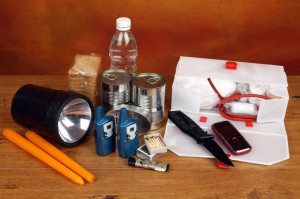 If you don’t have an emergency supply kit, you need one. It is essential for wildfire preparedness, and something you should have for all types of disasters and emergencies. You can purchase various types of emergency kits, and that is not a bad starting point for your kit, but it really needs to be personalized for you and your family.
If you don’t have an emergency supply kit, you need one. It is essential for wildfire preparedness, and something you should have for all types of disasters and emergencies. You can purchase various types of emergency kits, and that is not a bad starting point for your kit, but it really needs to be personalized for you and your family.
Basic Contents of an Emergency Supply Kit
- Change of clothes, keeping in mind any possible weather conditions, and the fact that you may need to sleep in them.
- First aid kit.
- Flashlight, with fresh batteries.
- Radio that is battery powered, or hand cranked.
- Three days of non-perishable food for each family member including infants and pets.
- Three gallons of water per person.
- Other snacks.
- A current map (no, you can’t just rely on GPS). If possible, mark your evacuation route and alternative routes, as well as shelters or other destinations.
- Phone charger.
- Medications and necessary supplements.
- Credit cards, cash, and extra checks.
- Important documents including a copy of your driver’s license, passports, birth certificates, and insurance papers.
- Extra glasses or contacts.
- Diapers and other baby supplies.
- Sanitary wipes for your hands.
- Something to keep the kids entertained, such as playing cards, drawing paper and crayons, or whatever works.
- Sturdy, comfortable shoes, if you aren’t normally wearing them.
- Your family communication plan.
- Other contact numbers. Do not rely on having important phone number stored in your phone.
Evacuation Grab Bag
Besides your emergency essentials, there are some things you probably don’t want to leave behind. Pack a bag you can grab at the last second with these items, or go ahead and put it in the car. Examples of what you might want in your evacuation grab bag include:
- Irreplaceable photos or negatives.
- Jewelry and other easily carried valuables.
- Laptops and hard drives.
- Sketchbooks and journals.
- Small treasured keepsakes.















